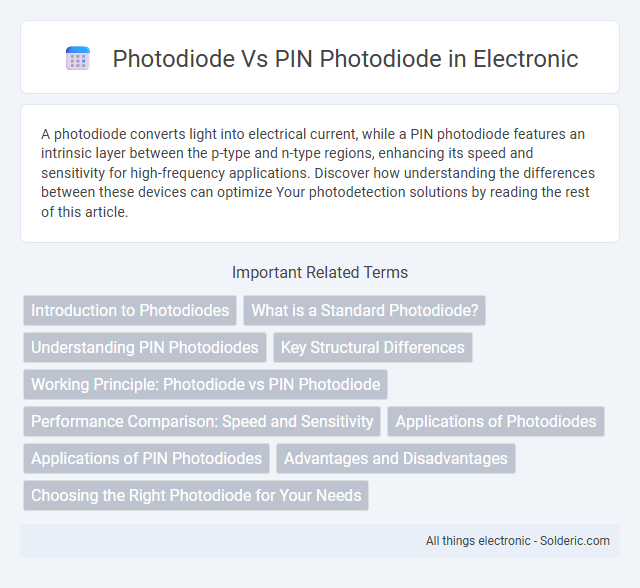A photodiode converts light into electrical current, while a PIN photodiode features an intrinsic layer between the p-type and n-type regions, enhancing its speed and sensitivity for high-frequency applications. Discover how understanding the differences between these devices can optimize Your photodetection solutions by reading the rest of this article.
Comparison Table
| Feature | Photodiode | PIN Photodiode |
|---|---|---|
| Structure | PN junction | P-layer, intrinsic layer, N-layer (PIN) |
| Response Speed | Moderate | High (due to intrinsic layer) |
| Sensitivity | Standard sensitivity | Higher sensitivity and quantum efficiency |
| Dark Current | Higher dark current | Lower dark current |
| Capacitance | Higher junction capacitance | Lower capacitance for faster response |
| Applications | General light detection | High-speed optical communication, photometry |
Introduction to Photodiodes
Photodiodes are semiconductor devices that convert light into electrical current, widely used in optical communication and sensing applications. PIN photodiodes feature an intrinsic layer between the p-type and n-type regions, enhancing their sensitivity and speed by reducing capacitance and increasing the depletion region. This structural advantage makes PIN photodiodes ideal for high-frequency and low-light environments compared to standard photodiodes.
What is a Standard Photodiode?
A standard photodiode is a semiconductor device that converts light into an electrical current by generating electron-hole pairs when exposed to photons. It typically has a simple p-n junction structure optimized for moderate speed and sensitivity in applications like light detection and optical communication. Compared to PIN photodiodes, standard photodiodes have a thinner intrinsic layer, resulting in faster response times but lower quantum efficiency and sensitivity.
Understanding PIN Photodiodes
PIN photodiodes feature an intrinsic layer between the p-type and n-type regions, enhancing their sensitivity and speed compared to standard photodiodes by increasing the depletion region width and reducing capacitance. This design allows for improved performance in high-frequency and low-light applications such as fiber-optic communications and laser rangefinders. Their ability to operate efficiently at wavelengths from 400 to 1100 nm makes PIN photodiodes essential components in advanced optical sensing and detection systems.
Key Structural Differences
A photodiode is a semiconductor device that converts light into electrical current, typically featuring a simple p-n junction, whereas a PIN photodiode incorporates an intrinsic (undoped) layer between the p-type and n-type regions. This intrinsic layer in the PIN photodiode increases the depletion region width, enhancing its sensitivity and response speed by reducing carrier transit time. Your choice between the two depends on the application requirements for sensitivity, speed, and wavelength range.
Working Principle: Photodiode vs PIN Photodiode
Photodiodes convert light into electrical current by generating electron-hole pairs when photons hit the semiconductor junction. PIN photodiodes enhance this process with an intrinsic layer between the p-type and n-type regions, increasing the depletion region width, which improves response speed and sensitivity. Your choice between a standard photodiode and a PIN photodiode depends on the required detection efficiency and speed for your application.
Performance Comparison: Speed and Sensitivity
PIN photodiodes offer significantly higher speed compared to regular photodiodes due to their intrinsic layer, which reduces junction capacitance and improves response time. Sensitivity in PIN photodiodes is enhanced because the intrinsic layer allows for greater photon absorption and efficient charge carrier generation. Regular photodiodes typically exhibit lower sensitivity and slower response, making PIN photodiodes preferable for high-speed optical communication systems.
Applications of Photodiodes
Photodiodes are widely used in optical communication systems, light detection, and medical devices due to their sensitivity to light and fast response time. PIN photodiodes, with their intrinsic layer, offer enhanced performance in high-speed and low-light applications such as fiber optic receivers, LIDAR, and spectroscopy, where greater sensitivity and low noise are critical. Your choice between a standard photodiode and a PIN photodiode depends on the specific requirements for speed, sensitivity, and wavelength range in your application.
Applications of PIN Photodiodes
PIN photodiodes are extensively used in high-speed optical communication systems, including fiber optic networks and photodetectors for laser rangefinders, due to their fast response time and high sensitivity. Their wide depletion region allows efficient detection of weak light signals, making them ideal for applications in medical imaging, barcode scanners, and safety equipment. Your choice of a PIN photodiode enhances performance in environments requiring precise and reliable light detection with minimal noise.
Advantages and Disadvantages
Photodiodes offer fast response times and high sensitivity but may have higher noise levels compared to PIN photodiodes. PIN photodiodes improve performance through an intrinsic layer, enhancing quantum efficiency and reducing junction capacitance, which results in lower noise and better high-frequency response. However, PIN photodiodes generally require higher reverse bias voltage and are more complex to manufacture, increasing cost compared to standard photodiodes.
Choosing the Right Photodiode for Your Needs
Selecting the right photodiode depends on sensitivity, speed, and noise performance requirements. Standard photodiodes are suitable for low-speed applications with moderate sensitivity, while PIN photodiodes offer higher sensitivity and faster response times due to their intrinsic semiconductor layer that reduces capacitance. For high-speed optical communication or precise light detection, PIN photodiodes provide superior performance, making them ideal for demanding environments.
Photodiode vs PIN photodiode Infographic

 solderic.com
solderic.com